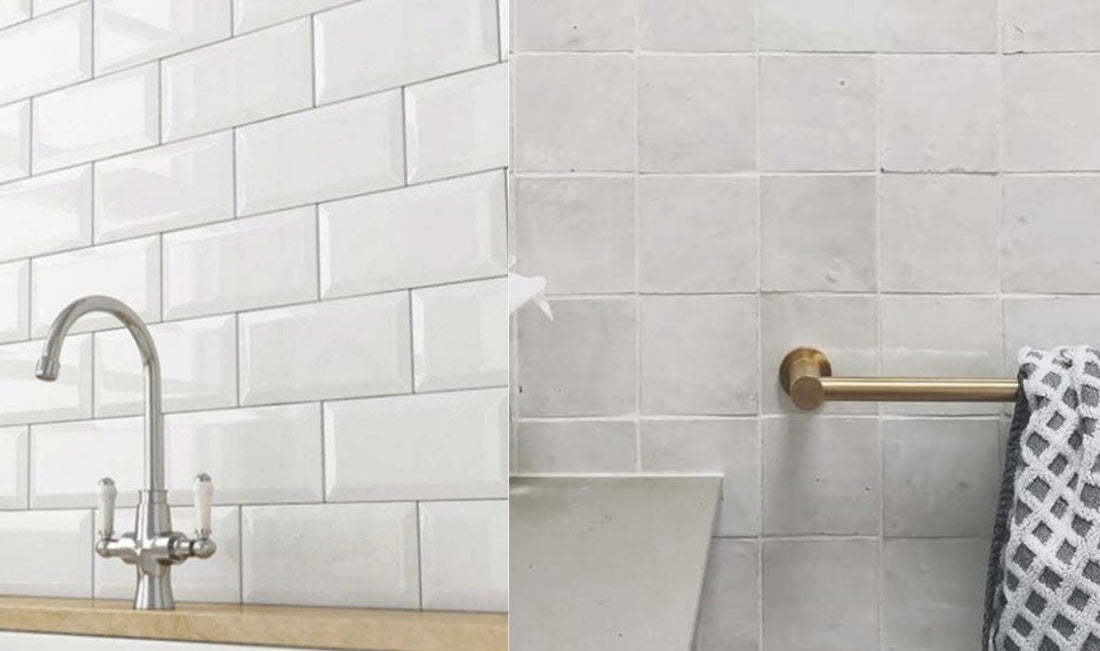
Zellige Tile vs. Subway Tile: How Zellige Tiles Enhance Contemporary Interiors
In interior design, tile is more than just a surface, it sets the tone for the entire space. It can blend in or stand out, ground a room or give it movement. Among the most popular options are subway tile, with its clean, consistent lines, and Moroccan Zellige tile, a centuries-old craft that brings texture, depth, and history to any wall it touches. Both are popular in kitchens and bathrooms. Both are made from clay. But that s where the similarities end.
Understanding their differences is essential for making the right design decision, one that reflects your style, your space, and the feeling you want to create.
The Origins and Materials: Handmade Moroccan Zellige Tile vs. Standard Subway
Tiles Subway tile is a product of industrial design. Born in New York in the early 1900s, its strength lies in its uniformity. It s mass-produced using refined clay and pressed into perfect rectangles by machines. The result is a smooth, predictable surface, often glazed in white or neutral tones, that s easy to install and easy to clean. It does its job quietly and efficiently. Zellige, on the other hand, is entirely handmade. It begins with raw, unrefined clay from the Fez region of Morocco. Artisans shape it by hand, dry it in the sun, fire it in kilns fueled by olive pits, and glaze each piece using mineral pigments before cutting it down to its final form. The process is slow and imperfect by design. Each tile carries the mark of the maker, the slightly uneven edges, the pooling glaze, the subtle variations in color and finish. Together, these elements create a surface that is rich with depth and natural beauty.
Texture, Light, and Movement in Moroccan Zellige Tiles
The surface of Zellige tiles is what sets them apart from any other tile on the market. Light reflects differently off each tile because no two are exactly the same. The glaze might be thick in one spot and thin in another. Some tiles crackle slightly or show small pits from the firing process. Rather than hiding these details, Zellige celebrates them. In a finished wall, the imperfections create a kind of rhythm, subtle but full of life. Subway tile offers the opposite effect. Its smooth, flat surface and uniform color reflect light evenly, creating a clean, crisp look. It s structured, minimal, and modern. In a space where you want the tile to sit quietly in the background, this uniformity works well. But when the goal is to bring warmth and movement to a room, Moroccan Zellige does something no machine-made tile can do. It transforms a flat surface into something layered and dimensional, even when the color is a soft white or neutral tone.
Design Style and Application: Where Moroccan Zellige Tiles and Subway Tile Shine In design
Subway tile is often the first choice for projects that lean toward simplicity or restraint. It s versatile, affordable, and works well in minimalist or transitional spaces. Many designers choose subway tile when they want to emphasize other design elements, like bold fixtures, cabinetry, or countertops, without distraction. Zellige, in contrast, becomes a focal point. Whether used in a kitchen backsplash, a shower wall, or around a fireplace, it draws the eye. Its organic surface softens modern spaces and adds texture to traditional ones. In Moroccan design, Zellige is used both functionally and ornamentally, to define fountains, walls, courtyards, and domes. When used in contemporary interiors, it brings the same sense of craftsmanship and rootedness. For smaller or more intimate spaces like a powder room or entryway, Zellige can create a feeling of quiet luxury. In kitchens, it pairs beautifully with natural materials like wood, stone, and plaster. In bathrooms, it brings softness and elegance to a space that often feels cold and sterile with standard tiles.
Craftsmanship, Care, and Durability of Moroccan Tiles vs. Subway Tile
Subway tile requires little thought after installation. It s non-porous, durable, and easy to wipe down with standard cleaners. This makes it a practical choice for busy households, rental properties, or commercial spaces where function takes priority. Moroccan Zellige tile does ask for a bit more care. Because the surface is varied and sometimes porous, it should be sealed during installation and cleaned with gentle, non-abrasive products. But this doesn t make it fragile. Zellige has been used for centuries in Moroccan architecture, from palace walls to hammam baths, and it s known to age gracefully. In fact, the longer it lives in a space, the more character it develops. Just as important, Zellige supports real artisanship. Buying handmade Moroccan tile directly supports the work of Moroccan craftspeople who are preserving techniques passed down through generations. It s a material with story and soul, something more and more designers and homeowners are seeking in the materials they choose.
Final Thoughts: Choosing Between Zellige Tiles and Subway Tile for Your Space
Tile is often one of the most permanent choices in a home. Once it s installed, it stays. That s why it s worth taking the time to understand what each material brings to the table. Subway tile is clean, modern, and easy. It s the workhorse of tile design, reliable, functional, and familiar. Zellige tiles are the opposite. They re expressive, textured, crafted by hand, and full of variation. They don t blend in, they stand out, but in a subtle, timeless way that s never overpowering. If your goal is to create a space that feels layered, warm, and full of texture, something that reflects both design and tradition, Moroccan Zellige tile is an ideal choice.
Ready to bring handcrafted texture and timeless design into your space?
Explore our curated collection of Moroccan Zellige tiles, available in a range of glazes, sizes, and finishes. Each tile is handmade by skilled artisans using traditional techniques passed down for generations.
Click here to see our handcrafted collection of Moroccan Zellige tiles
